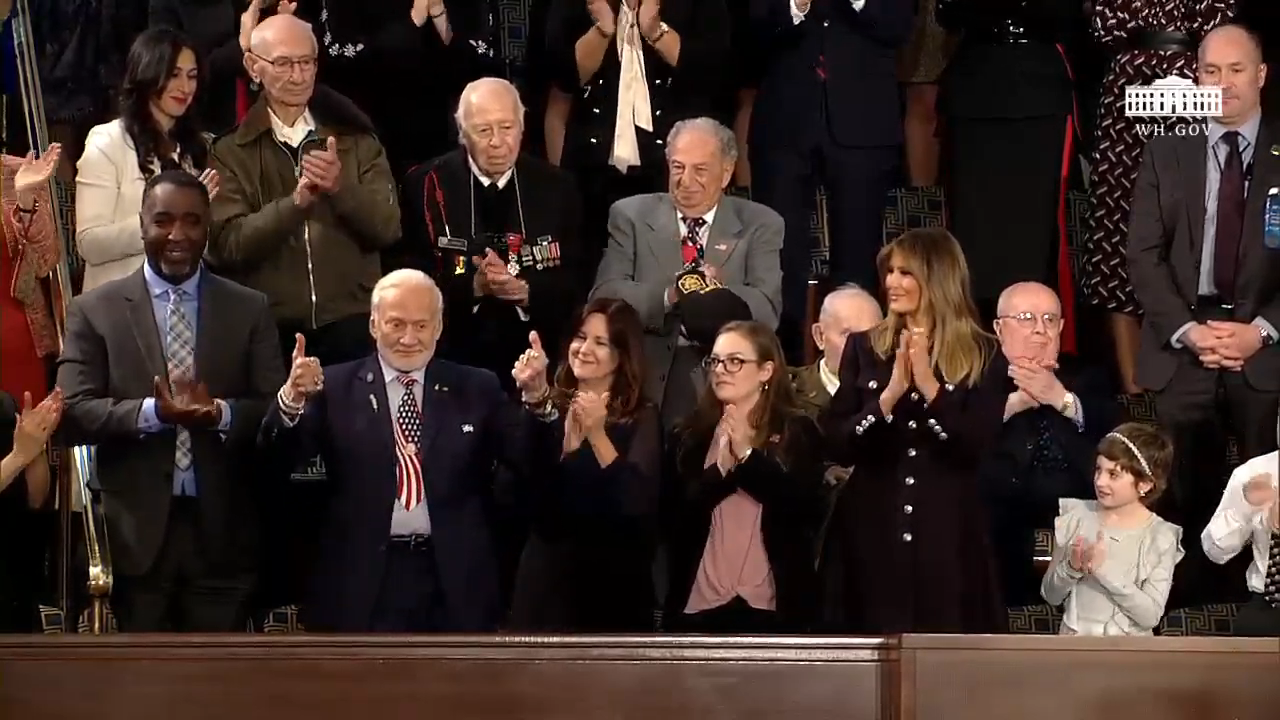Trump Honors 50th Anniversary of Apollo 11 Moon Landing in State of the Union Speech
During his State of the Union speech on Tuesday (Feb. 5), President Donald J. Trump gave a shout-out to NASA astronaut Buzz Aldrin as he commemorated the 50th anniversary of the Apollo 11 moon landing.
"In 2019, we also celebrate 50 years since brave young pilots flew a quarter of a million miles through space to plant the American flag on the face of the moon," Trump said. "Half a century later, we are joined by one of the Apollo 11 astronauts who planted that flag, Buzz Aldrin," he added before thanking Aldrin for his service. Aldrin served as lunar module pilot on NASA's historic Apollo 11 moon landing mission. He and Neil Armstrong landed on the moon on July 20, 1969 while their crewmate Michael Collins remained in lunar orbit aboard their command module.
Trump has directed NASA to return astronauts to the moon under his Space Policy Directive 1. The space agency is developing a Lunar Orbiting Platform Gateway to serve as a waystation to the moon, as well a massive Space Launch System megarocket and Orion spaceraft to reach the Gateway. NASA is also working with private companies developing commercial lunar landers for future moon missions. [Presidential Visions for Space Exploration: From Ike to Trump]
President Trump also gave a nod to NASA's commercial crew program, which could start launching astronauts to the International Space Station this summer. "This year, American astronauts will go back to space in American rockets," Trump said during his speech, referring to SpaceX's Crew Dragon and Boeing's CST-100 Starliner.

In 2014, NASA picked SpaceX and Boeing to build private spaceships to fly American astronauts to and from the International Space Station. SpaceX received contract worth $2.6 billion to fly astroanuts on its Crew Dragon spacecraft, while Boeing received a $4.6 billion deal to fly astronauts on its Starliner spacecraft.
SpaceX is currently aiming to launch its first uncrewed Crew Dragon test flight in February, with Boeing's uncrewed Starliner debut expected in March. If all goes well with those flights, and subsequent in-flight abort tests of both vehicles, SpaceX and Boeing could launch their first astronauts in the summer.
During his speech, President Trump also brought up "a state-of-the-art missile defense system" currently under development for the U.S. military before mentioning that the United States will withdraw from the Intermediate-Range Nuclear Forces treaty. "Decades ago the United States entered into a treaty with Russia in which we agreed to limit and reduce our missile capabilities," Trump said. "While we followed the agreement ... Russia repeatedly violated its terms. It has been going on for many years. That is why I announced that the United States is officially withdrawing from the Intermediate-Range Nuclear Forces treaty."
Get the Space.com Newsletter
Breaking space news, the latest updates on rocket launches, skywatching events and more!
In perhaps a surprising move, Trump did not mention his efforts to establish a Space Force as the sixth branch of the U.S. military during his State of the Union speech (even though the Administration cited it in a list of Trump's accomplishments during his first two years in office). Trump directed the Pentagon to form the Space Force during a meeting of the National Space Council on June 18, 2018, with Vice President Mike Pence unveiling details of the military branch in a subsequent meeting of the council. Currently, the Pentagon is eyeing potentially forming the Space Force inside the Air Force as it works to create it as a separate military branch.
In the meantime, Trump did issue an order in December to establish a Space Command as a unified combatant command. Since he took office, President Trump has also signed three other space policy directives. The first one, signed in December 2017, directed NASA to focus on a return to the moon with the ultimate goal of putting humans on Mars. The second directive, which he signed in May 2018, eased regulations on private spaceflight companies. A third directive took aim at space traffic control, which shifted oversight responsibilities for preventing collisions from space junk from the Defense Department to the Commerce Department.
Email Hanneke Weitering at hweitering@space.com or follow her @hannekescience. Follow us on Twitter @Spacedotcom and on Facebook. Original article on Space.com.
Join our Space Forums to keep talking space on the latest missions, night sky and more! And if you have a news tip, correction or comment, let us know at: community@space.com.

Hanneke Weitering is a multimedia journalist in the Pacific Northwest reporting on the future of aviation at FutureFlight.aero and Aviation International News and was previously the Editor for Spaceflight and Astronomy news here at Space.com. As an editor with over 10 years of experience in science journalism she has previously written for Scholastic Classroom Magazines, MedPage Today and The Joint Institute for Computational Sciences at Oak Ridge National Laboratory. After studying physics at the University of Tennessee in her hometown of Knoxville, she earned her graduate degree in Science, Health and Environmental Reporting (SHERP) from New York University. Hanneke joined the Space.com team in 2016 as a staff writer and producer, covering topics including spaceflight and astronomy. She currently lives in Seattle, home of the Space Needle, with her cat and two snakes. In her spare time, Hanneke enjoys exploring the Rocky Mountains, basking in nature and looking for dark skies to gaze at the cosmos.









